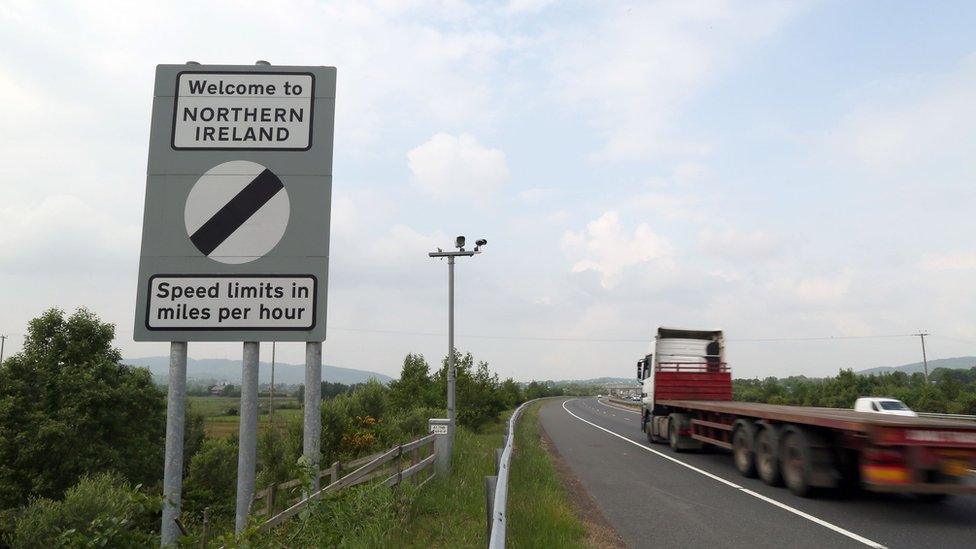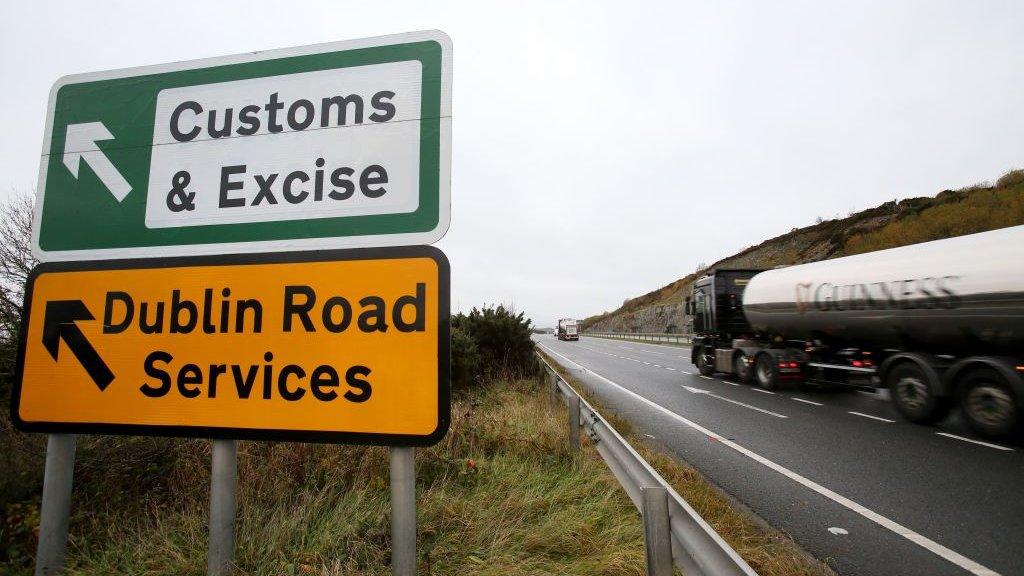Brexit: How the Irish border took centre stage in 2018
- Published

The Irish border has been one of the biggest sticking points during Brexit negotiations
In 2018, the Irish border assumed a greater role in British politics than at probably any time since it was created.
The debate has centred on what has become known as the backstop.
It set off a political row about sovereignty, Northern Ireland's place in the United Kingdom and the ultimate outcome of the Brexit process.
The backstop is a position of last resort to maintain a soft border on the island of Ireland.
The concept was actually unveiled in December 2017 in a joint report from EU and UK negotiators.
But when it was given draft legal form by the EU in March, the penny began to drop about exactly what it would mean.
At present, goods are traded between the two jurisdictions on the island of Ireland with few restrictions as they are both in the EU's single market and customs union.
After Brexit, all that could change - the two parts of Ireland could be in different customs and regulatory regimes, which could mean products being checked at the border.
That is something the UK and EU have promised to avoid.
What will become of the Irish border when the UK leaves the European Union?
So the EU's text essentially said that if no other solutions were found, Northern Ireland would have to stay in the customs union and large parts of the single market, unless and until a long-term deal emerged that kept the border as open as it is now.
The prime minister immediately rejected that.
Mrs May told the Commons: "The draft legal text would, if implemented, undermine the UK common market and threaten the constitutional integrity of the UK by creating a customs and regulatory border down the Irish sea, and no UK prime minister could ever agree to it."
The DUP, which Mrs May relies on for a majority in parliament, also weighed in on the debate.
The party's deputy leader Nigel Dodds described the EU's draft as "utterly preposterous" and "in some ways quite offensive".
However, Mrs May acknowledged that a withdrawal deal with the EU would have to involve a backstop.
So the next eight months involved a fraught negotiation, which eventually saw Mrs May moderating her position and the EU also making a big move.
Confused by Brexit jargon? Reality Check unpacks the basics
In April, Ireland's foreign minister Simon Coveney warned that there would be "difficulties" in the Brexit process if there was not substantial progress on the backstop at an EU summit in June.
June came and went without agreement, but by the end of the summer there were subtle changes in the language on both sides.
Michel Barnier, the EU's chief negotiator, struck a conciliatory tone in July when he said: "There will be a backstop, not necessarily our backstop, we can work, we can amend, we can improve."
In August, he put his words in writing, stating: "We are ready to improve the text of our proposal."
UK ministers began emphasising that the most important feature of the backstop was to guarantee that Northern Ireland would not be in a separate customs territory from the rest of the UK.
We heard much less about the regulatory border that the prime minister had decried in March.
The DUP were wise to this.
Their Brexit spokesman Sammy Wilson asked a series of increasingly pointed parliamentary questions about whether the prime minister was prepared to sign up to a backstop that would lead to Northern Ireland following many single market rules.

East Antrim MP Sammy Wilson reacted angrily to the government's Brexit text
A situation that would mean that goods moving from Great Britain into Northern Ireland would be subject to new checks.
The DUP appeared to get their answer when Dominic Raab, one of three men to be Brexit secretary this year, visited Northern Ireland in early November.
He refused to rule out any new regulatory checks at the Irish sea ports as part of the backstop.
Mr Raab even visited the veterinary inspection post at Larne Harbour where animals entering Northern Ireland from the rest of the UK are already subject to checks.
Brexit deal will not jeopardise UK integrity
On the EU side a change of position was also crystallising.
All along Mr Barnier had insisted the backstop could only apply to Northern Ireland, but now the EU was ready to concede that the customs part of the backstop could apply to the UK as whole.
The deal was finally unveiled in the middle of November. It had a Northern Ireland-only regulatory backstop and a UK-wide customs backstop.
This provoked fury in the DUP, with Nigel Dodds describing the backstop as "poisonous" and "the worst possible outcome".
'Global Britain'
But it is the UK-wide part of the backstop, rather than the treatment of Northern Ireland, that has caused the greatest difficulties for the prime minister.
If ever triggered, the backstop would last indefinitely and could not be ended unilaterally by the UK.
For many Conservative MPs that means the backstop is a trap that the EU can use to lock the UK into a customs union, killing the ambition of a "global Britain" with an independent trade policy.
Mrs May is now attempting to persuade Brussels to "clarify", or perhaps outright re-negotiate, the backstop in order to make it palatable to a majority of MPs.
So far that clarification has not been forthcoming.
- Published16 October 2019

- Published13 December 2018

- Published10 December 2018

